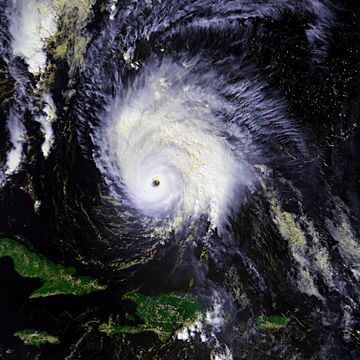Hurricane Hortense facts for kids
| Category 4 major hurricane (SSHWS/NWS) | |

Hurricane Hortense near peak intensity
|
|
| Formed | September 3, 1996 |
|---|---|
| Dissipated | September 16, 1996 |
| Highest winds | 1-minute sustained: 140 mph (220 km/h) |
| Lowest pressure | 935 mbar (hPa); 27.61 inHg |
| Fatalities | 39 direct |
| Damage | $158 million (1996 USD) |
| Areas affected | Guadeloupe, Virgin Islands, Puerto Rico, Dominican Republic, Turks and Caicos, Nova Scotia, Newfoundland |
| Part of the 1996 Atlantic hurricane season | |
Hurricane Hortense was a powerful storm that moved across the Atlantic Ocean in September 1996. It caused a lot of damage and sadly, many people lost their lives. Hortense hit several places, including Haiti, the Dominican Republic, and Puerto Rico. It also affected parts of eastern Canada.
Contents
What is a Hurricane?
Hurricanes are huge, spinning storms that form over warm ocean waters. They have strong winds and bring heavy rain. These storms are also called typhoons or tropical cyclones, depending on where they form. They get their energy from the warm water.
How Hurricanes Form
Hurricanes start as tropical disturbances. These are areas of stormy weather. If the ocean water is warm enough (at least 80°F or 26.5°C), the air above it rises. This creates an area of low pressure. More air rushes in, and the Earth's spin makes the storm rotate. As it gets stronger, it can become a tropical depression, then a tropical storm, and finally a hurricane.
Hurricane Hortense's Journey
Hurricane Hortense began as a tropical wave near Africa on September 3, 1996. It slowly grew stronger as it moved west across the Atlantic. By September 7, it became a tropical storm.
Hortense Becomes a Hurricane
On September 9, Hortense officially became a hurricane. It quickly gained strength. The storm passed near Guadeloupe and the Virgin Islands. It brought heavy rain and strong winds to these areas.
Impact on Puerto Rico and the Dominican Republic
Hortense made landfall in Puerto Rico on September 10 as a strong Category 3 hurricane. This means its winds were very fast, around 115 miles per hour (185 km/h). The storm caused widespread flooding and mudslides. Many homes were damaged, and power went out for a long time.
After hitting Puerto Rico, Hortense moved towards the Dominican Republic. It was still a very strong storm. It caused more flooding and damage there. Sadly, about 39 people died because of Hurricane Hortense. The total damage was estimated to be around $139 million.
Hortense Reaches Canada
After passing the Caribbean, Hortense moved north. It weakened a bit but still hit southeastern Nova Scotia, Canada, as a Category 1 hurricane. It brought heavy rain and strong winds to parts of Nova Scotia and Newfoundland. Even though it was weaker, it still caused some damage and power outages in Canada.
Why Hortense's Name Was Retired
When a hurricane causes a lot of damage or loss of life, its name is often "retired." This means the name will not be used again for another storm. This is done to remember the serious impact of the storm. Because Hurricane Hortense caused so much destruction and so many deaths, its name was retired in the spring of 1997.
Images for kids
-
Flooding caused by Hortense near Guayama, Puerto Rico
See also
 In Spanish: Huracán Hortense para niños
In Spanish: Huracán Hortense para niños




